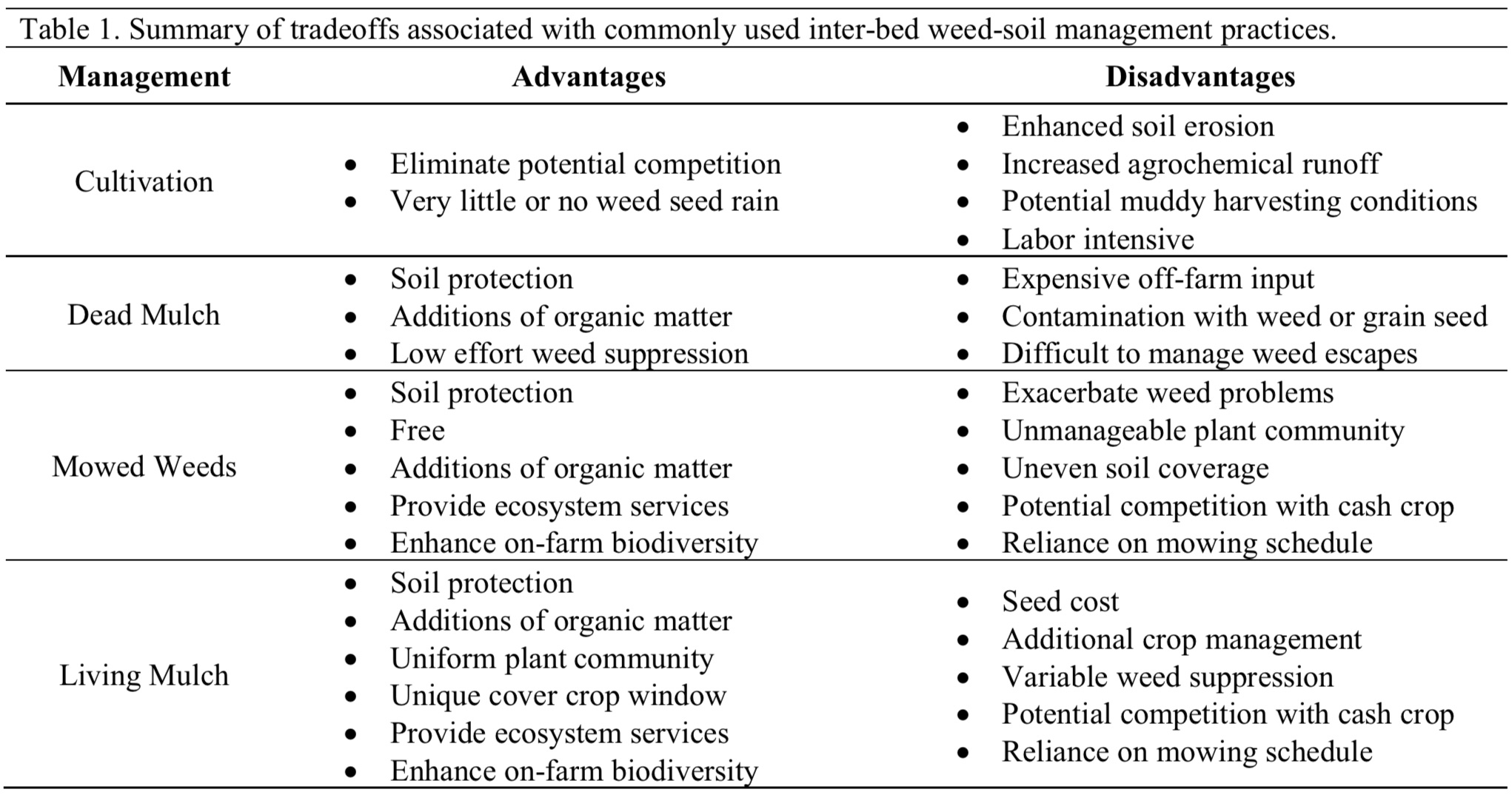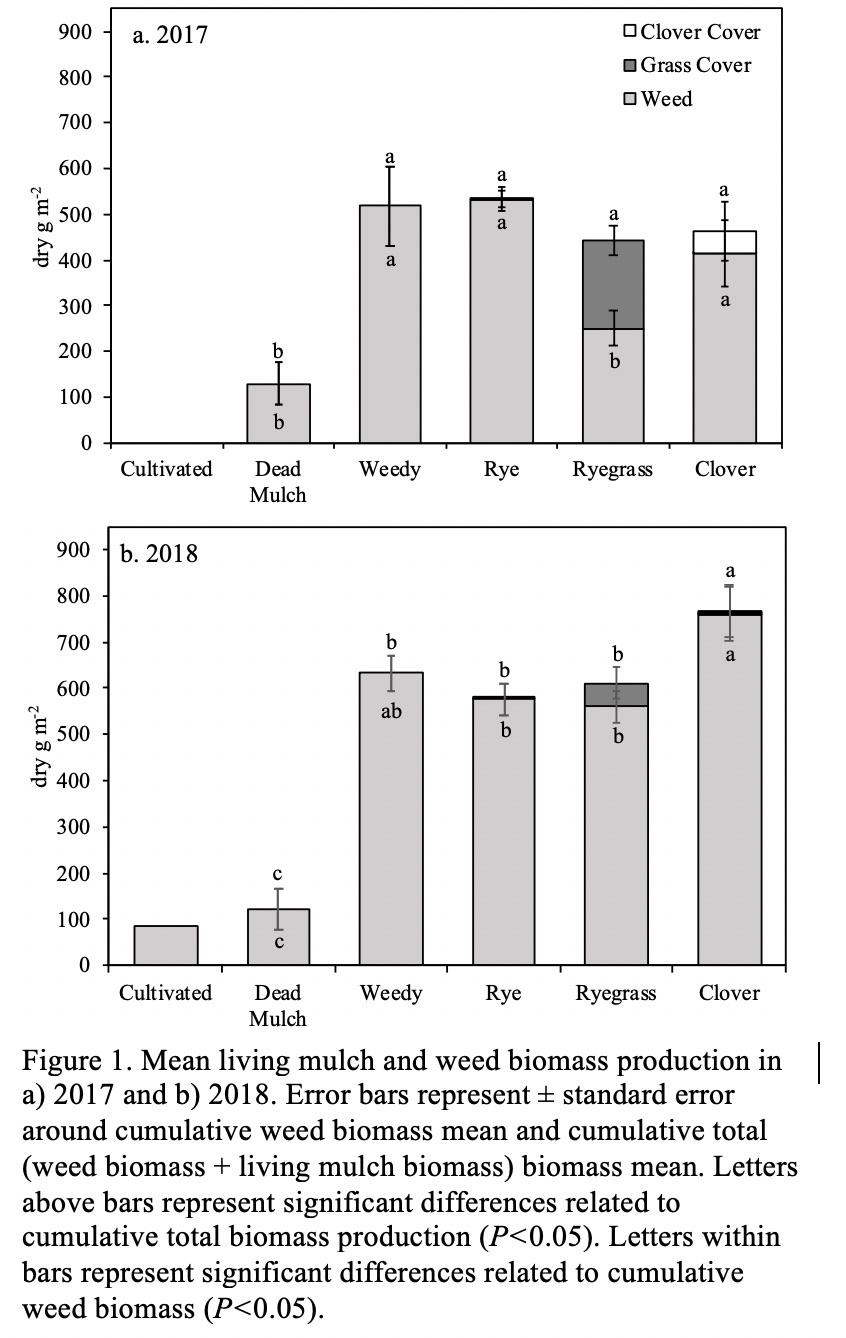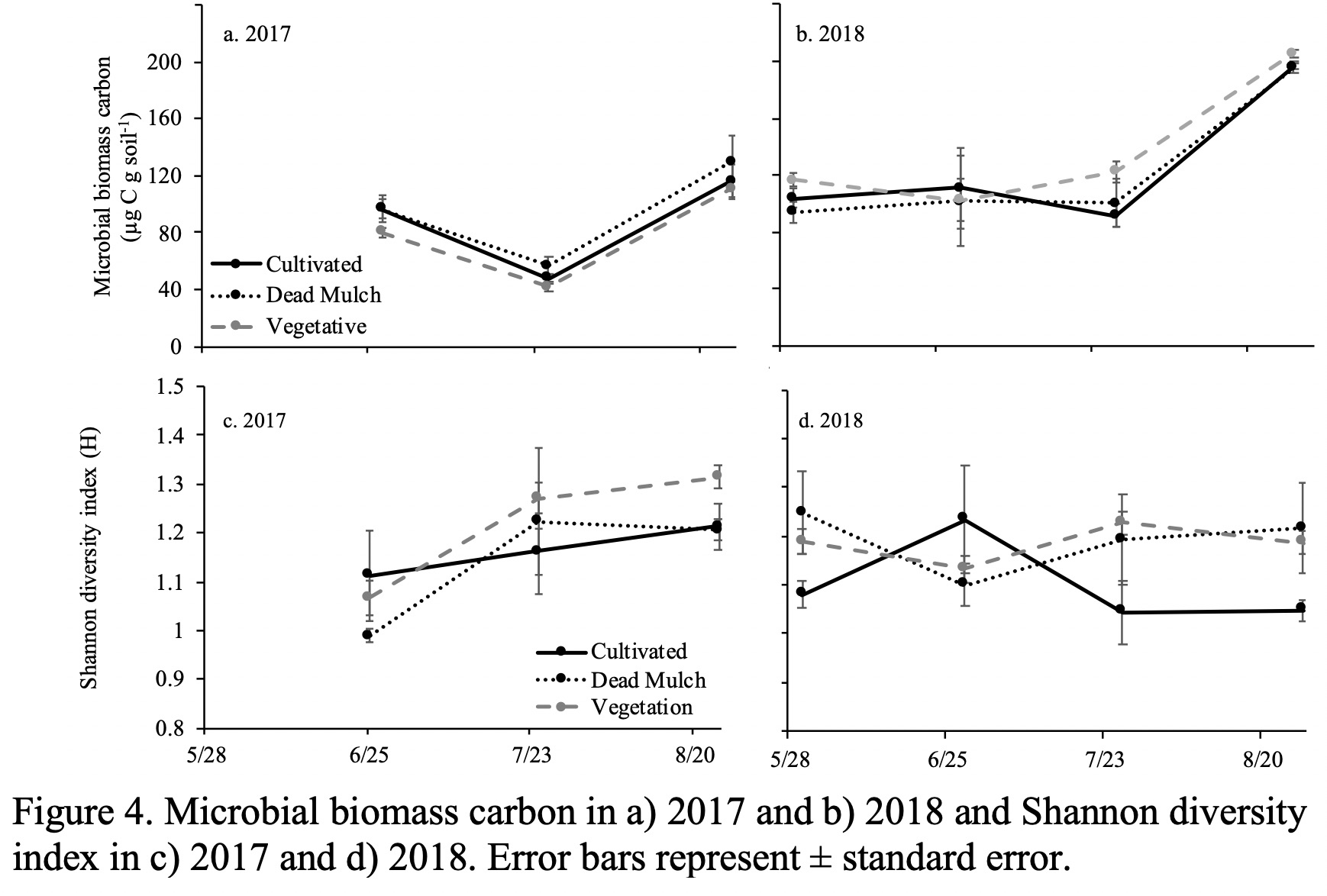Final report for GNC17-251
Project Information
Summary of Problem
The use of plastic mulch is common in warm-season vegetable production in the North Central Region. Excellent in-bed weed control provided by plastic films make it particularly attractive in organic production, though weeds between plastic mulch beds (referred to as “inter-bed” hereafter) remain a challenge. Many organic growers manage inter-bed weeds through cultivation. However, with roughly 50-75% of a field covered with impermeable plastic, sediment loss and associated agrochemical runoff in the inter-bed area can be greatly intensified during rain events (Arnold et al., 2004; Rice et al., 2004; Wan and El-Swaify, 1999; Zhang et al., 2013). Erosion can be mitigated by keeping the inter-bed soil covered with dead plant residues or cover crop living mulches and benefit soil health through organic matter inputs. However, additional management challenges associated with these practices may offset the advantages (Table 1.1). Since the best inter-bed weed management strategy will depend on a grower’s specific management goals, identifying production and soil health tradeoffs associated with various inter-bed weed and soil management practices will aid growers in making management decisions best suited to their agronomic and environmental goals. This research seeks to identify these important tradeoffs of inter-bed weed management practices and equip organic vegetable growers in the North Central Region with the information necessary to optimize inter-bed management strategies for improved crop production and soil health.
Literature Cited
Arnold, G. L., Luckenbach, M. W., and Unger, M. A. (2004). Runoff from tomato cultivation in the estuarine environment: biological effects of farm management practices. Journal of Experimental Marine Biology and Ecology,298(2), pp. 323–346. https://doi.org/10.1016/S0022-0981(03)00366-6
Rice, P. J., Harman-Fetcho, J. A., Teasdale, J. R., Sadeghi, A. M., McConnell, L. L., Coffman, C. B., … Hapeman, C. J. (2004). Use of vegetative furrows to mitigate copper loads and soil loss in runoff from polyethylene (plastic) mulch vegetable production systems. Environmental Toxicology and Chemistry, 23(3), pp. 719–725. https://doi.org/10.1897/03-14
Wan, Y., and El-Swaify, S. A. (1999). Runoff and soil erosion as affected by plastic mulch in a Hawaiian pineapple field. Soil and Tillage Research, 52(1–2), pp. 29–35. https://doi.org/10.1016/S0167-1987(99)00055-0
Zhang, G. S., Li, J. C., Hu, X. B., and Zhang, X. X. (2013). On-farm assessment of soil erosion and non-point source pollution in a rain-fed vegetable production system at Dianchi lake’s catchment, southwestern China. Nutrient Cycling in Agroecosystems, 96(1), pp. 67–77. https://doi.org/10.1007/s10705-013-9577-6
Research Approach
The objectives of this research were to 1) determine the influence of different management practices on in-season weed management and future weed pressure, 2) evaluate differences in labor requirements between management strategies, 3) assess the effects of weed management strategies on crop yield and quality, 4) study potential competition factors between living mulches and cash crops, 5) evaluate the nitrogen retention ability of different management strategies, and 6) determine the influence of different inter-bed management practices on soil microbial biomass and functional diversity as an indicator of soil health. A two-year experiment was conducted in southwest Michigan to these objectives. Strategies evaluated included wheel-hoe cultivation, rye (Secale cereale L.) residue dead mulch, mowed weeds, and three living mulch treatments: Italian ryegrass (Lolium multiflorum) monoculture, rye monoculture, and a rye-Dutch white clover (Trifolium repens) mixture. The treatments were implemented between plastic mulch beds planted with green bell peppers (Capsicum annuum cv. Paladin) and yellow summer squash (Cucurbita pepocv. Lioness).
Educational Approach
This research was inspired by organic growers’ frustrations with inter-bed weed management in plasticulture production, with specific interest in integrating a cover crop living mulch. In addition to the main trial outlined above a separate cover crop screen was conducted (funded by other sources) to evaluate ease of establishment, weed suppression, and biomass accumulation of various cover crop species. Seed of promising species (namely teff) from this screen were distributed to two growers in 2017 and six growers in 2018. Providing growers with the opportunity to try new practices on their farms helped us evaluate management constraints which can be difficult to identify in a research field. Through our work with grower collaborators we found that the adoption of integrated plasticulture-living mulch systems was primarily limited by labor demands. Poor living mulch establishment was also a constraint in some cases.
Summary of Conclusions
- Cultivation and dead mulch provided greater in-season weed control, with associated reductions in the weed seedbank, than living mulches and mowed weeds.
- Cultivating between the inter-bed area took more than twice as long as mowing weeds and living mulches.
- Squash yields were consistent across all treatments in both years, while pepper yields were reduced in all treatments relative to the cultivated control in 2018
- Pepper yield reductions may be attributed to competition for water.
- Living mulch or weeds in the inter-bed area showed the potential to reduce nitrogen leaching compared to cultivated and dead mulch plots.
- Microbial abundance and functional diversity were not significantly influenced by inter-bed weed management strategy over 2 seasons.
Grower Adoption Actions
Teff seed was distributed to Matt Martin of The Martin Family Farm (Capac, MI) and Mike Yancho of Forgotten Harvest Farm (Fenton, MI) to plant as a living mulch between plastic mulch beds on their farms in 2017 and 2018. Both Matt and Mike were interested in planting cover crops in the inter-bed to manage weeds, reduce soil erosion, and improve harvesting conditions.
Mike was pleased with the weed suppression and soil coverage achieved with teff in 2017. However, these results were not replicated in 2018, likely due to delayed planting of living mulch in that year resulting in weed escapes and poor establishment. Even though Mike experienced mixed results, he has commented that the potential benefits are worth the risks, and plans to continue the practice in the future.
Matt had limited success with teff, primarily because it needed to be mowed multiple times during the season, and labor shortages did not allow for timely management. Matt also experimented with buckwheat between plastic mulch beds and found it was easier to manage than teff because it did not regrow after mowing. Matt was also pleased with the level of weed suppression he was able to achieve with buckwheat. Matt continues to plant buckwheat between plastic mulch beds on his farm.
Teff seed was distributed to an additional four growers in 2018 with limited success. Having to manage the teff throughout the growing season was a major constraint for most of the collaborating growers.
The goal of this project is to evaluate the systems-level effects of different between-bed management strategies for vegetables grown on PM. The results from this study will provide detailed information regarding the functioning of individual parts and the system as a whole which will help farmers make informed inter-bed management decisions in PM systems to improve crop production, soil health, and environmental sustainability.
We anticipate the current study will result in the following outcomes:
Learning Outcomes:
- Vegetable farmers will have a greater awareness of alternatives to cultivation for weed and soil management between PM beds.
- Vegetable farmers, extension educators, and researchers will have a better understanding of how different inter- bed management practices in PM production influence system-level functioning.
Action Outcomes:
- Vegetable farmers will be empowered to try alternative inter-bed management strategies and evaluate them in the context of their specific production system.
- Vegetable farmers will make weed management decisions between PM beds which will improve soil health and reduce nutrient leaching.
- Researchers and extension educators will make well-rounded recommendations regarding inter-bed weed management in PM systems.
Environment/Production Outcomes
- Vegetable farmers will have the potential of greater profits as a result of reduced weeding costs, improved fruit quality, greater nutrient retention, and preservation and building of healthy soils.
- Environmental sustainability will be achieved through potential reductions in nutrient leaching and soil runoff.
Cooperators
- (Researcher)
- (Educator)
Research
Experimental Design
In May 2017 and 2018 a field experiment comparing different inter-bed management strategies in organic plasticulture vegetable production was conducted in Benton Harbor, Michigan (42°N, 86°W). The experiment was a split plot randomized complete block design with four replications. The whole plot factor was inter-bed management and included cultivated bare ground, cereal rye residue dead mulch, mowed ambient weeds, and three cover crop living mulch species: rye (Secale cerealeL.) monoculture, Italian ryegrass (Lolium multiflorum) monoculture, and a rye-Dutch white clover (Trifolium repens) mixture. Subplot factor was cash crop with two levels: green bell peppers (Capsicum annuum cv. Paladin) and yellow summer squash (Cucurbita pepocv. Lioness). The main plot factor was located in the same field and plot boundaries maintained across both years of the study to investigate the combined in-season and cumulative impacts of inter-bed management practices on soil quality and weed management. Cash crops were rotated between years. The soil at the experimental site was a Spinks (Sandy, mixed, mesic Lamellic Hapludalfs) and Selfridge (Loamy, mixed, active, mesic Aquic Arenic Hapludalfs) loamy sand.
Field Management
Dates of key field operations are outlined in Table 2. In mid-May, the field received 112 kg total N ha-1as organic fertilizer (Nature Safe “All-Season 10-2-8,” Irving, TX). Plastic mulch beds were laid on 1.67 m centers within one week of fertilizer application.
Inter-bed management strategies  were established at the end of May. Living mulches were broadcast sown by hand into inter-bed areas and lightly incorporated using a rake. Italian ryegrass and rye were seeded at 35.9 kg ha-1and 168.1 kg ha-1respectively in 2017. In 2018, the rye seeding rate was doubled to 336.3 kg ha-1in an attempt to address poor establishment in 2017. In both years, Dutch white clover was seeded at 22.4 kg ha-1with rye at half the monoculture rate (84 and 168 kg ha-1in 2017 and 2018, respectively) to act as a nurse crop.
were established at the end of May. Living mulches were broadcast sown by hand into inter-bed areas and lightly incorporated using a rake. Italian ryegrass and rye were seeded at 35.9 kg ha-1and 168.1 kg ha-1respectively in 2017. In 2018, the rye seeding rate was doubled to 336.3 kg ha-1in an attempt to address poor establishment in 2017. In both years, Dutch white clover was seeded at 22.4 kg ha-1with rye at half the monoculture rate (84 and 168 kg ha-1in 2017 and 2018, respectively) to act as a nurse crop.
Cash crops were planted at the same time as inter-bed management strategy establishment. Peppers were transplanted and grown staked in off-set double rows with 0.30 m between-row spacing and 0.46 m in-row spacing. Squash were direct seeded and grown in single rows with 0.61 m in-row spacing. All beds were drip irrigated simultaneously with two 20 min irrigation intervals per day as is standard grower practice in the area.
Inter-bed living mulches and weeds were mowed 2-3 times each season using a walk-behind push mower with the mower deck set to 10.16 cm. Since broadleaf summer annual weeds were typically the tallest plant in the inter-bed area, mowing events were determined by the height of weeds. Cultivated plots were maintained through hand cultivation using a wheel-hoe. Dead mulch consisted primarily of cereal rye that was flail mowed two days prior to mulching and applied at an approximate rate of 18 MT ha-1.
Data Collection
Weed Suppression: Above-ground biomass samples in dead mulch, mowed 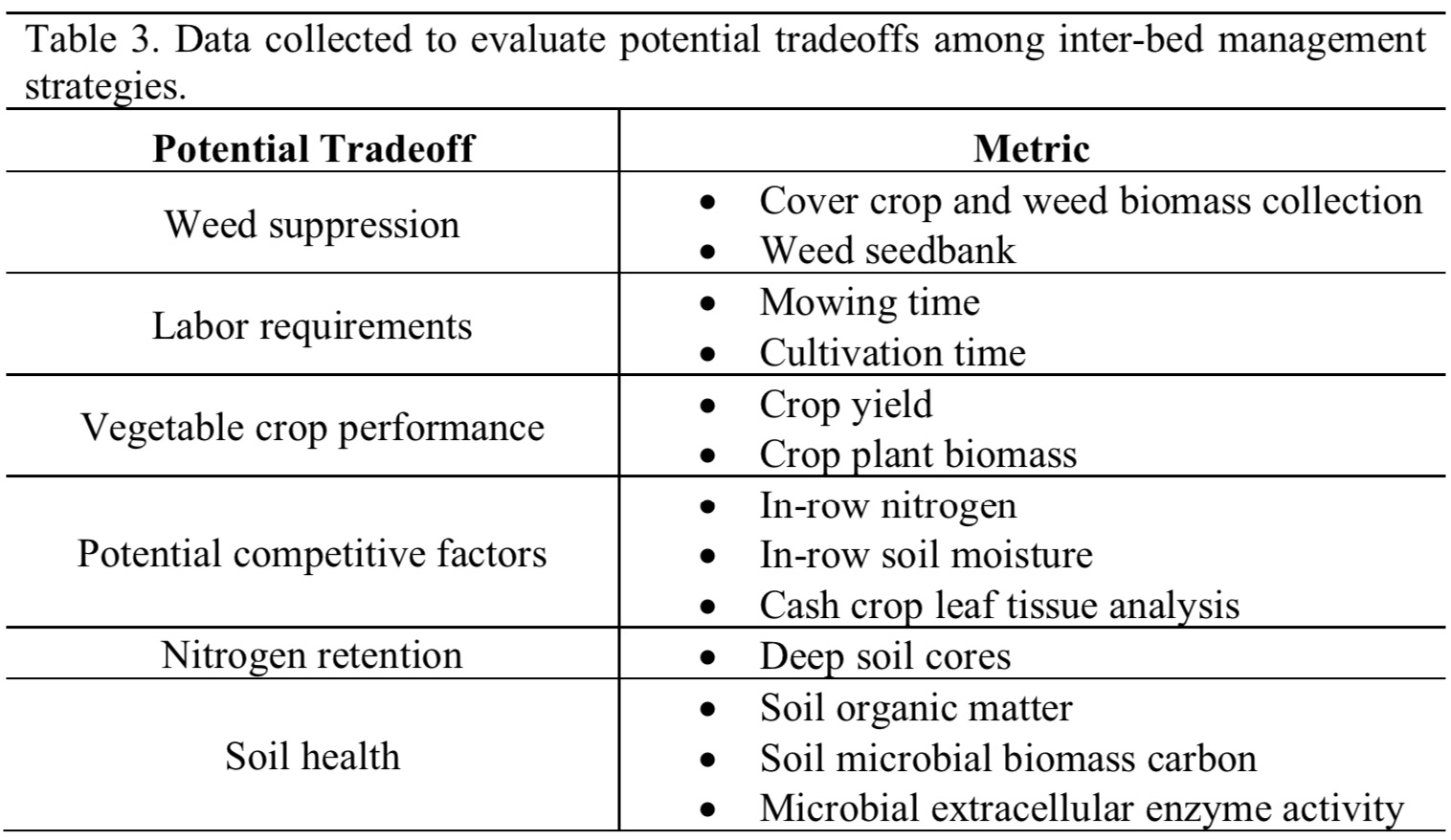 weeds, and living mulch plots were taken from permanent 0.125 m-2 quadrats in each inter-bed area per plot prior to all mowing events and at experiment termination. Biomass was collected above 10.16 cm prior to mowing events (to reflect height of mowing) and to the ground at experiment termination. Weed and living mulch biomass were separated and dried before dry weight determination. Ambient weeds in cultivated plots in 2017 were negligible, and thus biomass was not collected in cultivated plots in that year. However, in 2018, wet conditions caused delayed cultivation and led greater weed escapes. Therefore, weed biomass was collected in two cultivated replicates before the last cultivation event. Soil samples to evaluate the weed seedbank were collected in April of 2018 and 2019. Samples were taken to a 20 cm depth to reflect fall tillage depth from inter-bed areas. Composite samples were stored at 4°C before transferring to the greenhouse for weed seed germination within a week of field collection. Upon germination, weed seedlings were counted and removed.
weeds, and living mulch plots were taken from permanent 0.125 m-2 quadrats in each inter-bed area per plot prior to all mowing events and at experiment termination. Biomass was collected above 10.16 cm prior to mowing events (to reflect height of mowing) and to the ground at experiment termination. Weed and living mulch biomass were separated and dried before dry weight determination. Ambient weeds in cultivated plots in 2017 were negligible, and thus biomass was not collected in cultivated plots in that year. However, in 2018, wet conditions caused delayed cultivation and led greater weed escapes. Therefore, weed biomass was collected in two cultivated replicates before the last cultivation event. Soil samples to evaluate the weed seedbank were collected in April of 2018 and 2019. Samples were taken to a 20 cm depth to reflect fall tillage depth from inter-bed areas. Composite samples were stored at 4°C before transferring to the greenhouse for weed seed germination within a week of field collection. Upon germination, weed seedlings were counted and removed.
Labor requirements: The time required to cultivate and mow was measured after workers had gained experience with both methods in 2017. As a result, time requirements were estimated based on two of three mowing events, and three of four cultivation events in 2017. In 2018, time requirements for all mowing and cultivation events were recorded. Labor times were converted to minutes 10-m-1row for more meaningful comparisons between treatments.
Vegetable crop performance: Harvested squash fruit were categorized based on market standards, counted, and weighed. Harvested pepper fruit were categorized according to USDA standards (Agricultural Marketing Service, 2005), counted, and weighed. Individual harvest events were summed to obtain cumulative yield, then adjusted to a per plant basis for analysis.
Potential competitive factors: In-bed soil samples were collected under plastic mulch beds to a depth of 20 cm for each cash crop on a monthly basis starting at trial establishment. Composite samples were analyzed for inorganic N concentration (NO3- and NH4+). In-bed soil volumetric water content in the top 20 cm of soil was also monitored regularly using a FieldScout time-domain reflectometer probe (Spectrum Technologies Inc., Aurora, IL). Leaf tissue of each vegetable crop was collected at last harvest and sent to A & L Great Lakes Laboratories (Fort Wayne, IN) for full nutrient analysis.
Nitrogen retention: One 2.54 cm diameter soil core per main plot was collected to 60 cm depth in September of each year to evaluate potentially leachable nitrogen remaining in the soil profile at the end of each season. Continuous cores were collected into plastic liners using a steel sampling tube driven into the ground by a portable gas-powered hammer. Cores were separated into 20 cm depth intervals and analyzed for inorganic N concentration.
Soil health: Inter-bed soil samples for microbial analysis were taken at monthly intervals starting at trial establishment. Samples were placed in a cooler for temporary storage in the field and during transport to the lab where they were stored at 4°C until processing. Within one week of sampling, soil was passed through a 4mm sieve to remove rocks and large roots and evaluated for microbial biomass carbon and a subsample frozen for later use in extracellular enzyme assays.
Microbial biomass carbon was determined using the chloroform-fumigation-extraction method adapted from Vance et al. (1987). Extracts were kept at -20°C until analysis using a Shimadzu total organic carbon analyzer (TOC-V cpn, Shimadzu Corporation, Kyoto, Japan) in 2017 and using a Vario TOC Cube (Vario TOC select, Elementar Americas Inc, Ronkonkoma, NY) in 2018.
Extracellular enzyme assays were used to assess the activities of the following eight enzymes: two cellulases (-1,4-glucosidase (BG) and cellobiohydrolase (CBH)); a chitinase (-1-2-N-acetylglucosaminidase (NAG)); a peptidase (leucine amino hydrolase (LAP)); urease; an enzyme responsible for releasing phosphorus from soil organic matter (phosphate-monoester phosphohydrolase (PHOS)); phenol oxidase; and peroxidase. Enzyme activity was assessed following a method adapted from Saiya-Cork et al. (2002). To evaluate soil functional diversity, the Shannon diversity index was calculated from extracellular enzyme activity as has been described by previous authors (Bending et al., 2002; Zak et al., 1994).
Literature Cited
Agriculture Marketing Service. (2005). United States Standards for Grades of Sweet Peppers. Retrieved January 3, 2019 from https://www.ams.usda.gov/grades-standards/sweet-peppers-grades-and-standards.
Bending, G. D., Turner, M. K., and Jones, J. E. (2002). Interactions between crop residue and soil organic matter quality and the functional diversity of soil microbial communities. Soil Biology and Biochemistry, 34(8), pp. 1073–1082. https://doi.org/10.1016/S0038-0717(02)00040-8
Vance, E. D., Brookes, P. C., and Jenkinson, D. S. (1987). Microbial biomass measurements in forest soils: The use of the chloroform fumigation-incubation method in strongly acid soils. Soil Biology and Biochemistry,19(6), pp. 697–702. https://doi.org/10.1016/0038-0717(87)90051-4
Zak, J., Willig, M., Moorhead, D., and Wildman, H. (1994). Functional diversity of microbial communities: A quantitative approach. Soil Biology and Biochemistry, 26(9), pp. 1101–1108. https://doi.org/10.1016/0038-0717(94)90131-7
Weed suppression
Compared to seasonal precipitation averages, 2017 was relatively dry and 2018 relatively wet, particularly in May. Within a week following living mulch sowing, the field received 1.5 mm of rain in 2017 compared to 44.2 mm in 2018. Excessive early season rain in 2018 may explain living mulch establishment issues in that year.
The three living mulch treatments included in this trial were chosen to reflect a range of desirable living mulch characteristics. For example, rye was chosen because of its ability to establish rapidly, produce allelochemicals, and remain low-growing in the absence of vernalization (Ateh and Doll, 1996; Walters and Young, 2008). Italian ryegrass was selected because, as a turf-type grass, it has been shown to effectively cover the ground while remaining low-growing in the summer months (Masiunas et al., 1997; Sarrantonio and Gallandt, 2003).White clover was included under the assumption that its ability to fix atmospheric nitrogen may make it more adaptable to the low-fertility inter-bed area (Hartwig and Ammon, 2002; Verret et al., 2017). In the specific context and conditions of this study, the quick germination and season-long vigor of Italian ryegrass was important for establishment in a field with heavy weed pressure. However, living mulches generally produced very little biomass, with Italian ryegrass averaging only 192 g m-2and 51 g m-2 in 2017 and 2018 respectively (Figure 1). Low rye biomass production is likely attributable toestablishment challenges and the development of leaf rust in mid-July which nearly eliminated stands. The slow growth of clover and the failure of rye as a nurse crop caused the clover-rye mixture to be easily outcompeted by aggressive summer annual weeds. As a result of poor living mulch establishment and competitiveness, total plant biomass production in all living mulch treatments was typically dominated by weeds
Italian ryegrass was the only living mulch treatment to significantly reduce in-season weed pressure in either year, with a 51% reduction in weed biomass compared to the weedy check in 2017. The following year, no living mulch treatment reduced in-season weed biomass production relative to the weedy check. In comparison, weed biomass in the dead mulch treatment was significantly reduced in both years compared to the weedy check. Cultivated plots remained weed-free in 2017. However wet field conditions and delayed cultivation in 2018 resulted in modest weed growth in the cultivated treatmentat the end of July. Since weed biomass in cultivated plots was collected in only two of four treatment replicates in 2018, this treatment was excluded from statistical analysis. Nevertheless, cumulative weed biomass production in the cultivated treatment appeared to be substantially less than in living mulch and weedy check treatments.
Labor requirements
Though cultivation provided more effective weed control than living mulches, wheel-hoe cultivation took two to three times longer than mowing living covers and weeds in both years (Table 4). Although, it should be noted that weeds along the edge of plastic mulch beds were difficult to mow with our method, and mowed plots often required hand removal of weeds that spread onto bed tops. Labor times do not include this additional step. Even after this additional step, these weeds could escape the mower blade. In an attempt to mediate this challenge, weeds were hand cultivated along the edge of plastic early in the 2018 season. Hand cultivation along the edge of plastic was relatively undemanding, taking about 9.6 sec 10 m-1, and this strategy alleviated some management problems at the first mowing. However, effective mowing still proved challenging at the second event.
Vegetable crop performance
A primary limitation of living mulch adoption is the risk of cash crop interference (Hartwig and Ammon, 2002). While plastic mulch has the potential to serve as a spatial buffer and physical barrier to competition, previous studies suggest that reduced cash crop yield remains a challenge when inter-bed areas are managed with vegetative cover (Butler, 2012; Chen et al., 2017; Ivy et al. 2014; Law et al., 2006; Nelson and Gleason, 2018; Reid and Klotzbach, 2013; Warren et al., 2015). In this trial, summer squash yields were maintained across treatments in both years and 2018 pepper yields were consistent across treatments (Table 5, Table 6). In 2017, however, peppers grown in dead mulch, living mulch, and the weedy check plots experienced yield losses between 46 and60% compared to the cultivated treatment (Table 6).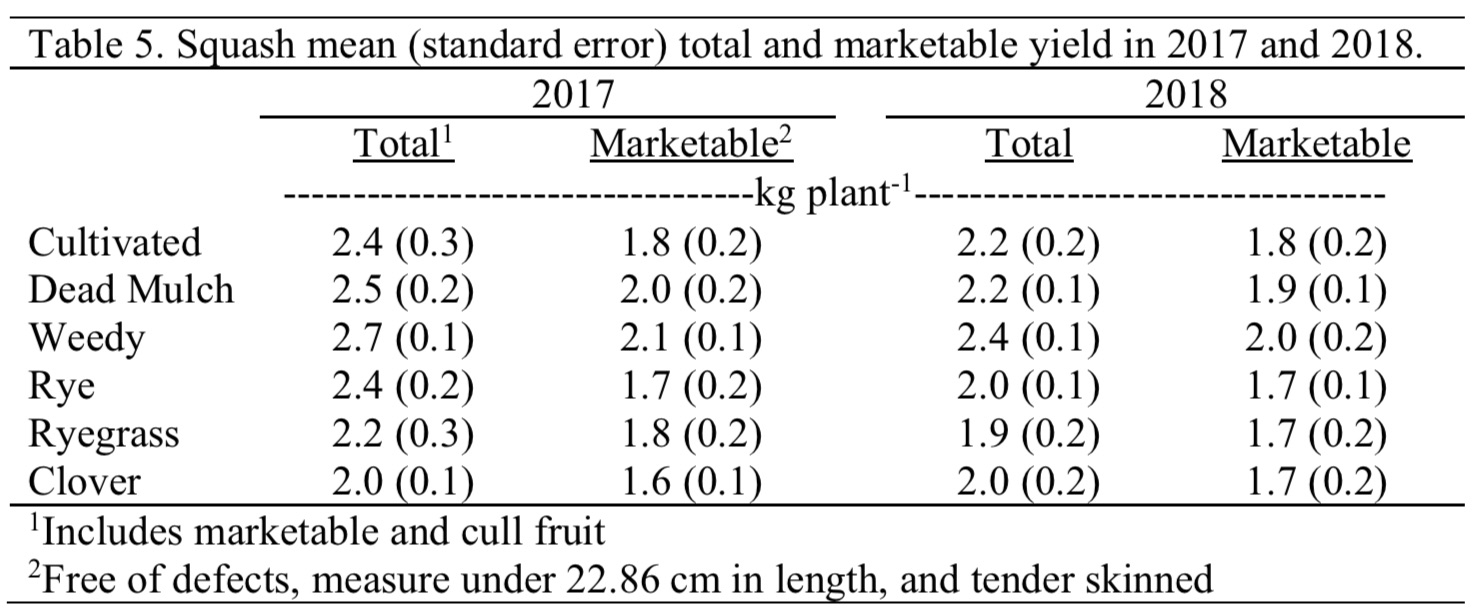
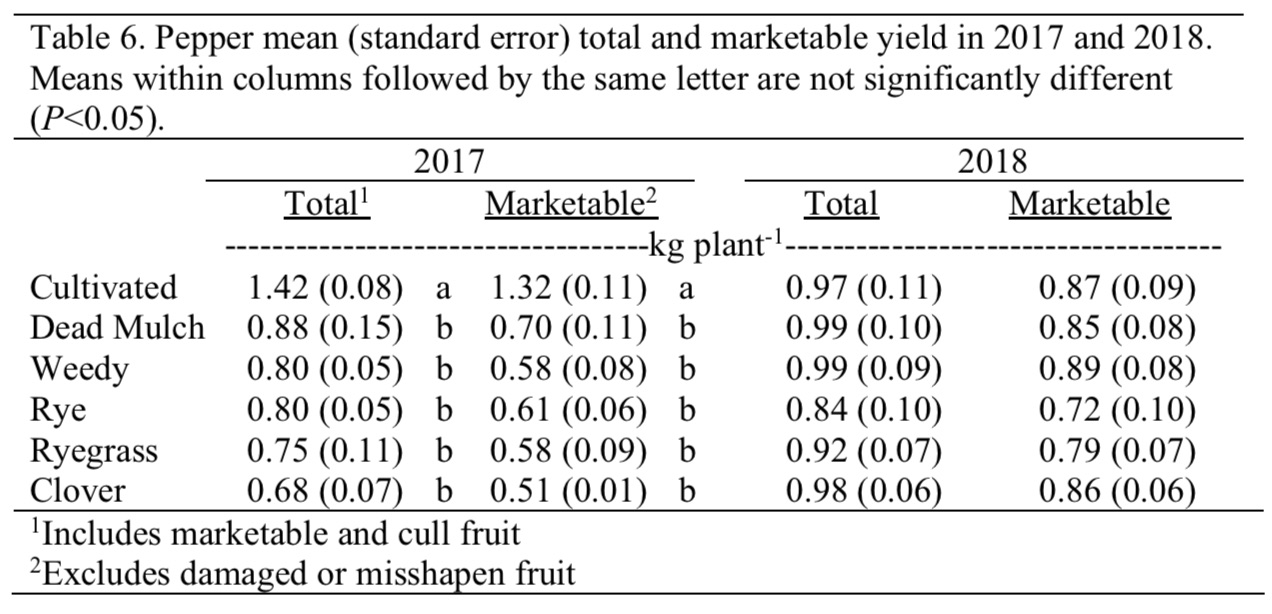
Potential competitive factors
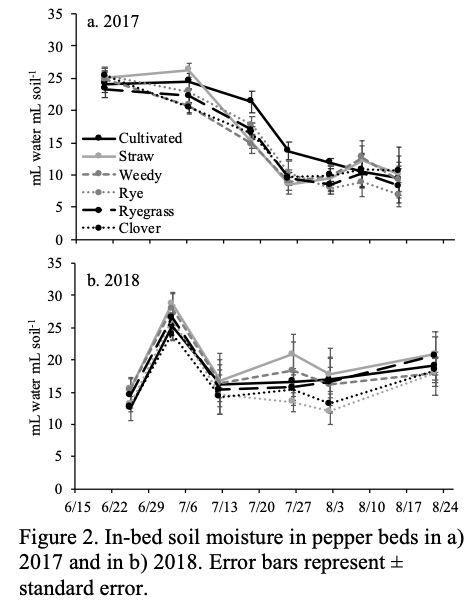 In 2017, in-bed soil moisture was generally higher in the cultivated control compared to all other treatments during pepper fruit development, potentially explaining yield reductions (Figure 2). Additionally, pepper leaf N concentration at last harvest was greater in the cultivated control relative to all other treatments. This may have resulted from nitrogen competition or N transport issues resulting from lower water availability in all treatments relative to the cultivated treatment. Comparable pepper yield reductions in the dead mulch, living mulch and weedy check treatments are initially surprising given significant differences in plant biomass growing in the inter-bed areas among these treatments. However, weeds that were present in the dead mulch treatment were concentrated along the edge of beds where they are most likely to compete for in-bed resources. The suppression of living mulch and associated weeds through mowing, the use of selective herbicides, spatial separation of living mulch and cash crops, or delayed planting of living mulches have been suggested to minimize yield reductions caused by living mulches (Masiunas, 1998). We found that spatial separation and mowing were not enough to mitigate potential competition. However, delayed utilization of in-bed resources by living mulches and weeds in this study suggest that competitive inhibition could be reduced or eliminated if living mulch was planted later, and inter-bed areas kept weed-free for some critical period.
In 2017, in-bed soil moisture was generally higher in the cultivated control compared to all other treatments during pepper fruit development, potentially explaining yield reductions (Figure 2). Additionally, pepper leaf N concentration at last harvest was greater in the cultivated control relative to all other treatments. This may have resulted from nitrogen competition or N transport issues resulting from lower water availability in all treatments relative to the cultivated treatment. Comparable pepper yield reductions in the dead mulch, living mulch and weedy check treatments are initially surprising given significant differences in plant biomass growing in the inter-bed areas among these treatments. However, weeds that were present in the dead mulch treatment were concentrated along the edge of beds where they are most likely to compete for in-bed resources. The suppression of living mulch and associated weeds through mowing, the use of selective herbicides, spatial separation of living mulch and cash crops, or delayed planting of living mulches have been suggested to minimize yield reductions caused by living mulches (Masiunas, 1998). We found that spatial separation and mowing were not enough to mitigate potential competition. However, delayed utilization of in-bed resources by living mulches and weeds in this study suggest that competitive inhibition could be reduced or eliminated if living mulch was planted later, and inter-bed areas kept weed-free for some critical period.
Nitrogen retention
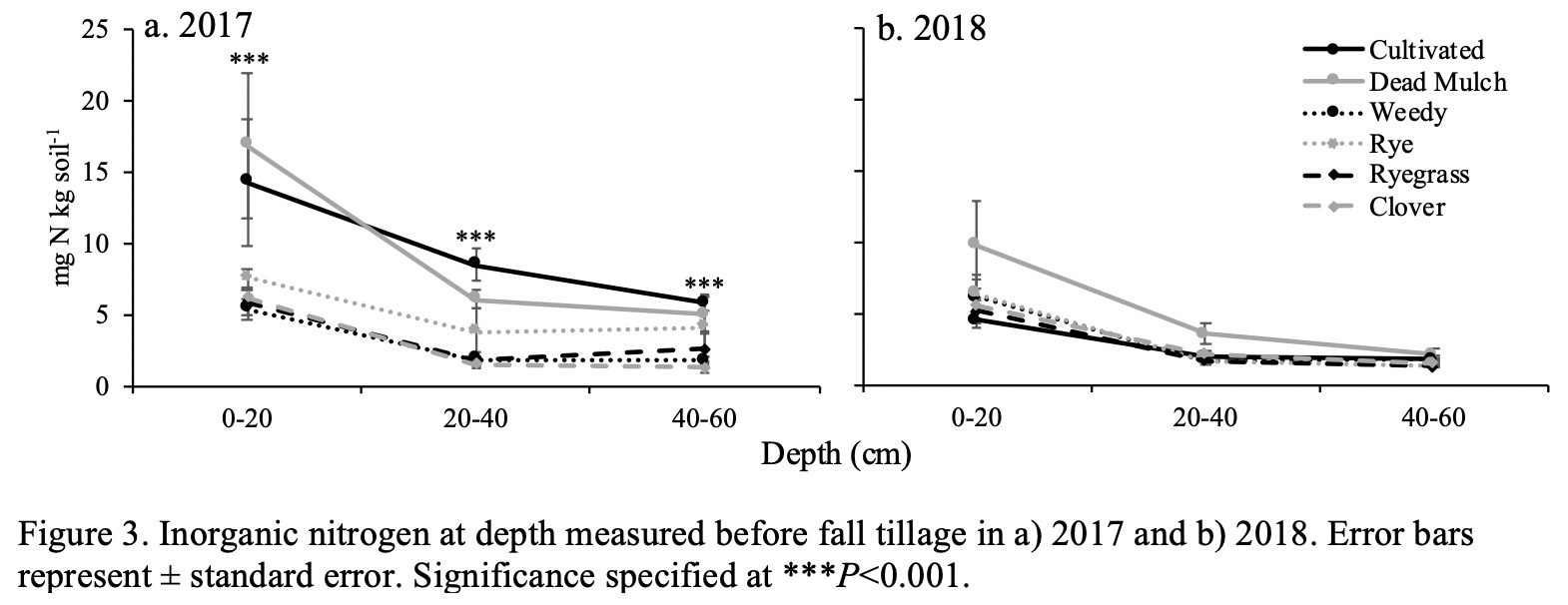 Although living mulches and weeds can present challenges related to weed control and cash crop performance, their potential to provide other ecosystem services may still support their adoption. For example, living mulch can reduce soil and agricultural chemical runoff (Masiunas, 1998), provide above- and below-ground habitat for beneficials (Depalo et al., 2017; Frank and Liburd, 2005)and maintain cleaner harvesting conditions. Furthermore, support for reduced N leaching with inter-bed vegetation was observed in this study (Figure 3).
Although living mulches and weeds can present challenges related to weed control and cash crop performance, their potential to provide other ecosystem services may still support their adoption. For example, living mulch can reduce soil and agricultural chemical runoff (Masiunas, 1998), provide above- and below-ground habitat for beneficials (Depalo et al., 2017; Frank and Liburd, 2005)and maintain cleaner harvesting conditions. Furthermore, support for reduced N leaching with inter-bed vegetation was observed in this study (Figure 3).
Another potential advantage of inter-bed mulching techniques is the addition of organic residues. Shoot biomass inputs in mowed weeds and living mulch treatments averaged 490 g dry m-2in 2017 and 647 g m-2. Dead mulch was applied at an average rate of 1,778 g m-2and had an additional input of 130 g m-2of weed shoot biomass in 2017 and 122 g m-2in 2018. Weed biomass production in the cultivated treatments was negligible in 2017 and averaged only 85 g m-2in 2018. Despite these differences in organic matter inputs between treatments, no significant differences in microbial biomass C or in the Shannon diversity index (used a proxy for functional diversity) were observed between the treatments evaluated in this study (Figure 4). These results challenged our expectation, with previous research demonstrating a positive correlation between living shoot and root biomass and soil microbial abundance and between organic matter inputs and extracellular enzyme diversity (Buyer et al., 2010; Finney et al., 2017). Lack of treatment effect may be attributed to the coarse textured soil at the experimental field, where changes in the microbial communities can be harder to detect than in heavier soils (Tiemann and Grandy, 2015).
Literature Cited
Ateh, C. M., and Doll, J. D. (1996). Spring-Planted Winter Rye (Secale cereale) as a Living Mulch to Control Weeds in Soybean (Glycine max). Weed Technology, 10(2), pp. 347–353.
Butler, R. A. (2012). Evaluation of cover crops and mowing as alternative approaches for weed control in organic tomato production(M.S., Purdue University). Retrieved from http://search.proquest.com.proxy1.cl.msu.edu/docview/1220693576/abstract/162EA7431ABF4BB1PQ/1
Buyer, J. S., Teasdale, J. R., Roberts, D. P., Zasada, I. A., and Maul, J. E. (2010). Factors affecting soil microbial community structure in tomato cropping systems. Soil Biology and Biochemistry, 42(5), pp. 831–841. https://doi.org/10.1016/j.soilbio.2010.01.020
Chen, G., Kolb, L., Leslie, A., and Hooks, C. R. R. (2017). Using Reduced Tillage and Cover Crop Residue to Manage Weeds in Organic Vegetable Production. Weed Technology, 31(04), pp. 557–573. https://doi.org/10.1017/wet.2017.24
Depalo, L., Burgio, G., von Fragstein, P., Kristensen, H. L., Bavec, M., RobaÄer, M., … Canali, S. (2017). Impact of living mulch on arthropod fauna: analysis of pest and beneficial dynamics on organic cauliflower (Brassica oleracea L. var. botrytis) in different European scenarios. Renewable Agriculture and Food Systems; Cambridge, 32(3), pp. 240–247. http://dx.doi.org.proxy2.cl.msu.edu/10.1017/S1742170516000156
Finney, D. M., Buyer, J. S., and Kaye, J. P. (2017). Living cover crops have immediate impacts on soil microbial community structure and function. Journal of Soil and Water Conservation, 72(4), pp. 361–373. https://doi.org/10.2489/jswc.72.4.361
Frank, D. L., and Liburd, O. E. (2005). Effects of Living and Synthetic Mulch on the Population Dynamics of Whiteflies and Aphids, Their Associated Natural Enemies, and Insect-Transmitted Plant Diseases in Zucchini. Environmental Entomology, 34(4), pp. 857–865. https://doi.org/10.1603/0046-225X-34.4.857
Hartwig, N. L., and Ammon, H. U. (2002). Cover Crops and Living Mulches. Weed Science, 50(6), pp. 688–699.
Ivy, A., Davis, M., Reid, J., Reiners, S. (2014). Inter-Row Cover Crops for Plasticulture Vegetables. Retrieved April 1, 2019 from http://www.nnyagdev.org/wp-content/uploads/2011/12/NNYADP2014IvyInterRowCCReportText.pdf
Law, D. M., Rowell, A. B., Snyder, J. C., and Williams, M. A. (2006). Weed Control Efficacy of Organic Mulches in Two Organically Managed Bell Pepper Production Systems.HortTechnology, 16(2), pp. 225–232.
Masiunas, J. B., Eastburn, D. M., Mwaja, V. N., and Eastman, C. E. (1997). The Impact of Living and Cover Crop Mulch Systems on Pests and Yields of Snap Beans and Cabbage. Journal of Sustainable Agriculture, 9(2–3), pp. 61–89. https://doi.org/10.1300/J064v09n02_06
Nelson, H., and Gleason, M. (2018). Comparing Between-Row Mulches in Organic Muskmelon and Squash – Year 2. Farm Progress Reports,2017(1). https://doi.org/10.31274/farmprogressreports-180814-1942
Reid, J., and Klotzbach, K. (2013). Final Report for ONE12-171. Retrieved April 1, 2019, from https://projects.sare.org/project-reports/one12-171/
Sarrantonio, M., and Gallandt, E. (2003). The Role of Cover Crops in North American CroppingSystems. Journal of Crop Production,8(1–2), pp. 53–74. https://doi.org/10.1300/J144v08n01_04
Tiemann, L. K., and Grandy, A. S. (2015). Mechanisms of soil carbon accrual and storage in bioenergy cropping systems. GCB Bioenergy, 7(2), pp. 161–174. https://doi.org/10.1111/gcbb.12126
Verret, V., Gardarin, A., Pelzer, E., Médiène, S., Makowski, D., and Valantin-Morison, M. (2017). Can legume companion plants control weeds without decreasing crop yield? A meta-analysis. Field Crops Research, 204, pp. 158–168. https://doi.org/10.1016/j.fcr.2017.01.010
Walters, S. A., and Young, B. G. (2008). Utility of Winter Rye Living Mulch for Weed Management in Zucchini Squash Production. Weed Technology, 22(4), pp. 724–728.
Warren, N. D., Smith, R. G., and Sideman, R. G. (2015). Effects of Living Mulch and Fertilizer on the Performance of Broccoli in Plasticulture. HortScience, 50(2), pp. 218–224.
Educational & Outreach Activities
Participation Summary:
- This research has been personally communicated to growers interested in adopting living mulch strategies. In 2018 seed of promising living mulch species (namely teff) was distributed to six organic vegetable farmers around Michigan to trial.
- Five oral presentations have been given regarding this research: Southwest Michigan Hort Days (Feb. 7, 2018), Great Lakes Vegetable Working Group Annual Meeting (Feb. 27-28, 2018), Plant Science Graduate Student Research Symposium (March 30, 2018), American Society for Horticulture Science Annual Conference (July 31-Aug. 3, 2018), and Northeast Cover Crops Council Annual Meeting (Nov. 15-16, 2018).
- Five poster presentations have been given regarding this research: Great Lakes Expo (Dec. 5-7, 2017), SARE Our Farms, Our Future Conference (April 3-5, 2018), Midwest Ecology and Evolution Conference (April 6-8, 2018), Plant Science Graduate Student Research Symposium (March 30, 2018), and Great Lakes Expo (Dec. 4-6, 2018).
- This research was the basis of Alyssa Tarrant's Master's Thesis. The thesis was successfully submitted to the Michigan State Graduate School in May 2019.
Project Outcomes
Economic Outcomes:
- Providing living mulch seed to growers allowed them to experiment with planting a living mulch between plastic mulch beds without having to invest in seed. This allowed collaborating growers to try the practice with relatively little financial investment before deciding if the practice was feasible. At least two growers have started growing living mulches between plastic mulch beds regularly, while others decided it did not make sense in their specific context.
Environmental Outcomes:
- We found that living mulch and weedy treatments reduced nitrogen leaching compared to cultivation or dead mulching. Growers can use this information to better make sustainable management decisions.
Social Benefit Outcomes:
- Collaborating growers were empowered to try new management practices with relatively low risk.
- Regular communication with growers allowed us to relay information from our trial and other growers, and allowed collaborating growers the opportunity to voice questions or concerns.
- This research was presented at four grower meetings.
Growers in our area were particularly interested in integrating living mulches into plasticulture production. By distributing living mulch seed to interested growers, we were able to identify challenges that we would not have seen within our field trial alone. Conversations with growers participating in this project improved the content of this research immensely. Having this opportunity affirmed the importance of including farmers in management research, particularly in sustainable agricultural practices.
This research elucidated three main themes that growers should take into consideration when making weed management decisions in plasticulture vegetable production.
- Anything growing between plastic mulch beds has the potential to compete with a cash crop, but management decisions can reduce risks.
This was evident where pepper yield was reduced in all treatments relative to the cultivated treatment 2017. However, differences in yield response between pepper and summer squash suggest that competitive interference may be mediated through cash crop selection. Additionally, differences in pepper yield response between years imply that yield reductions are likely dependent on year to year weather conditions. Furthermore, though not evaluated in this study, delayed living mulch planting has shown promise in other cases for mitigating competition.
- Ecosystem services provided by living mulches are possible, but not guaranteed, particularly weed suppression.
In both years we found that weed suppression by living mulches was variable and generally poor. However, Italian ryegrass was able to reduce in-season weed pressure by more than 50% in 2017. For growers interested in sowing a living mulch between plastic mulch beds for weed control, emphasis should be placed on living mulch establishment and biomass accumulation. However, if weed suppression is a primary concern for growers, dead mulches and cultivation are likely better options. Additionally, we did not observe any clear advantage of mulches on the soil microbial community during two season. However, living mulch and weedy covers are certainly contributing additional organic matter to the soil and showed the potential to reduce nitrogen leaching compared to cultivation and dead mulching.
- Other ecosystem services and disservices not measured here should be considered before implementing any strategy.
Other tradeoffs not considered by this research may be relevant to growers when making management decisions in plasticulture production. In addition to the tradeoffs measured in this study, the influence of these strategies as they relate to pest pressure, beneficial insect populations, crop rotation, and harvesting conditions should also be considered.
